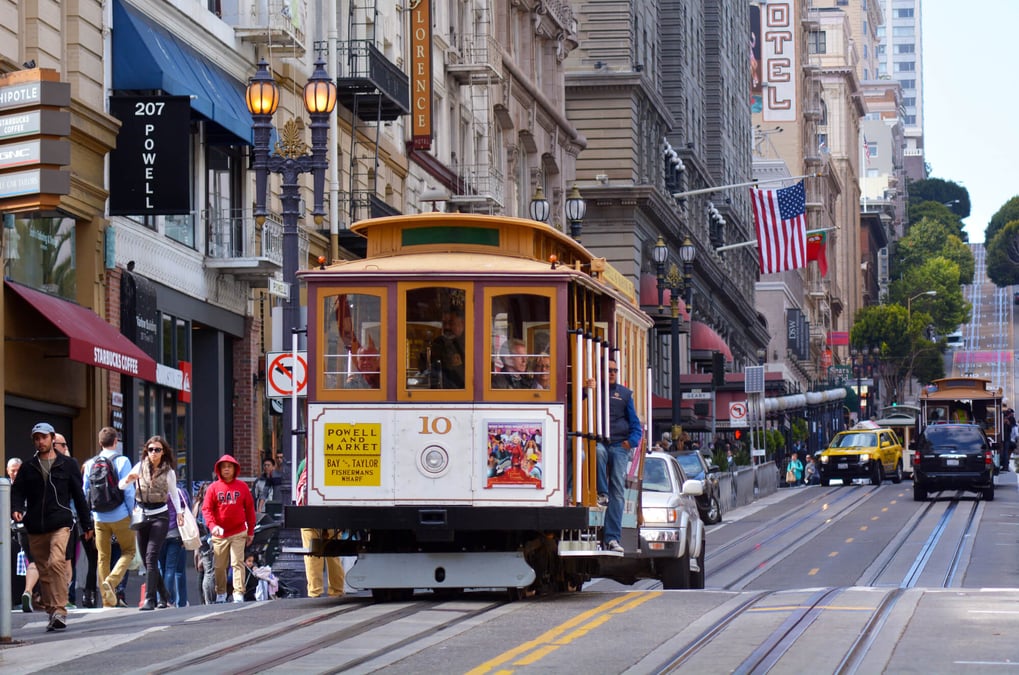Also sometimes called a trolley, street car, or funicular, cable cars are still used today in areas that offer an alternative for folks who want to get up and down a particularly steep hill. From Prague, Czech Republic to Valparaiso, Chile, these are often less about a daily commute and more about sightseeing or getting an amazing view of the city from the top of a very high hill.
Cable Car Day is set aside to celebrate and show respect for this unique form of travel!
History of Cable Car Day
In early 1871 British-born, US resident Andrew Smith Hallidie received the first patent in relation to the cable car, an occasion that in today’s world is marked by Cable Car Day. Hallidie’s design for cable-propelled transit emerged when he witnessed horses falling, and even dying, while attempting to pull cars up San Francisco’s steep Jackson Street.
Fortunately for San Franciscan equines, Hallidie had the talent to turn his sympathy into action. Having previously invented a type of aerial tramway and designed improvements to mining ropes which resulted in their economic life extending by more than 873%, Hallidie was just the man to solve this problem!
Two years after receiving his cable car patent, Hallidie set up the world’s first cable car rail road on Clay Street. None of the original line still survives today, but grip car 8 is preserved in Mason Street’s Cable Car Museum (which, as it should be, sits on two of San Francisco’s three cable car routes).
Today, more than 150 years later, the cable car is considered to be a moving national landmark for the city of San Francisco, and Cable Car Day is here to celebrate these and the others all over the world!
How to Celebrate Cable Car Day
Enjoy the fun and adventure of engineering by enjoying Cable Car Day with some of these ideas:
Ride a Cable Car
San Francisco, California is one of the places that is most notable for cable cars, especially since that’s where they began. So a visit to this city would certainly be a superb way to celebrate Cable Car Day and give a nod to this genius invention of engineering.
Those who find themselves outside of San Francisco on Cable Car Day can still get in on the fun. Other cities operating cable car railways include Los Angeles, California; Tampa, Florida; Pittsburgh, Pennsylvania; Las Vegas, Nevada; Milan, Italy and a variety of other cities around the country and the world. But, even folks who are nowhere near a cable car railroad can still honor the origins of this invention by patting a horse on the head!
Share Fun Facts for Cable Car Day
Looking to show friends or family members how interesting cable cars are? Check out some of these interesting tidbits of cable car trivia, remember a few, and then bring them up in casual conversation in honor of Cable Car Day:
-
The signature cable for these cars is basically a rope that is made from steel, to offer strength and durability.
-
The technology for cable cars was originally used for hauling passengers and ore in a mining camp and it implemented the cable overhead as an “aerial tramway”. But the street version with tracks proved to be better.
-
In San Francisco, the first cable car line came at a hefty price tag of $85150, which translates to more than $1.6 million today.
-
Before an earthquake in 1906, San Francisco had more than 600 cable cars, but the fleet was sadly reduced to less than 100 by 1912. Today it only has 40 cars.
Learn More About Cable Cars
An excellent way to give some respect to Cable Car Day would be to head over to the local library and pull out some books on the subject. Of course, for those who prefer to stay home, plenty of research about cable cars can be accomplished through some internet searching. Learn about Andrew Smith Halladie and his process of developing the cable car, as well as seeing the places throughout the world where the technology has been implemented.
Start by checking out book titles including The Cable Car Book by Charles Smallwood (1980) or The Cable Car in America by George W. Hilton (1997).

